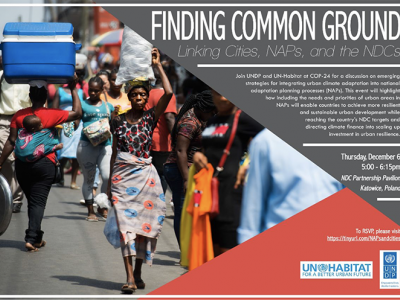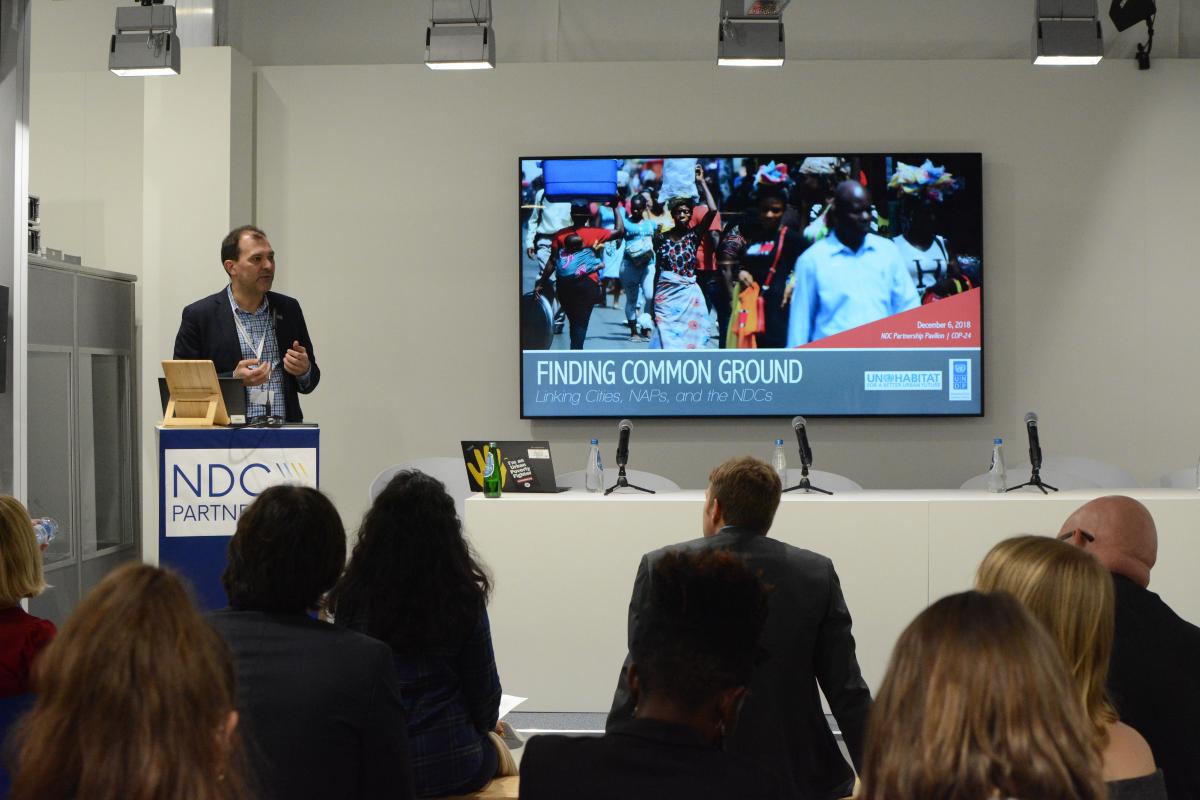COP24 side event: Finding common ground: Linking cities NAPs and the NDCs
Submitted by esther.lake@undp.org on 17 December 2018

6 December 2018, COP24, Katowice, Poland: A COP24 side event was convened by UNDP and UN-Habitat entitled Finding Common Ground: Linking Cities, NAPs and the NDCs.
 The panel discussion outlined existing activities underway to connect cities to NAPs and NDCs, identified barriers to further integration, and explored the financing needs and possibilities for scaling up adaptation planning in cities. In the face of climate change, urgent action is needed to address the inter-connected issues of poverty, governance, and climate vulnerability – both at the national level and in cities.
The panel discussion outlined existing activities underway to connect cities to NAPs and NDCs, identified barriers to further integration, and explored the financing needs and possibilities for scaling up adaptation planning in cities. In the face of climate change, urgent action is needed to address the inter-connected issues of poverty, governance, and climate vulnerability – both at the national level and in cities. The event, held at the NDC Partnership Pavilion, was moderated by Marcus Mayr (UN-Habitat) and Rohini Kohli (UNDP) and centered around a panel discussion with Ignacio Lorenzo, Climate Change Director, Ministry of Housing, Territorial Planning, and Environment, Government of Uruguay, Manuel Araujo, Mayor of the City of Quelimane, Mozambique, and Ulrika Åkesson, Lead Policy Specialist for Environment and Climate at the Swedish International Development Cooperation Agency (SIDA).
Rohini Kohli and Marcus Mayr provided an introduction to the topic, linking cities, NAPs and NDCs. They underscored the fact that in order to deliver the adaptation needs and priorities of nations, as detailed in their Nationally Determined Contributions (NDCs), robust and comprehensive National Adaptation Plans (NAP) are an important tool. And, cities are a critical location to achieve these NDC targets.
Rohini Kohli explored how integrating the needs and priorities of urban areas into NAPs will enable countries to achieve more resilient and sustainable urban development while reaching the country’s NDC targets and directing climate finance into scaling up investment in urban resilience. She underscored how integration requires close cooperation between national governments, local authorities and non-state actors. UNDP works in nearly 170 countries and territories working with these actors to support climate risk informed city planning via development of vulnerability assessments and early warning and climate information systems, incorporation of adaptation principles into national policies, planning and budgeting processes, and implementation of ecosystem-based adaptation projects in urban areas.
Marcus Mayr outlined how as the global population becomes over two-thirds urban by 2050 (UNDESA 2018), urban areas are increasingly facing a range of climate change risks and impacts including sea level rise, extreme events, and variability.
He outlined how UN-Habitat have identified 113 countries which have urban priorities in their NDCs. Though much of this urban content is focused on adaptation, cities and urban areas are also key to achieving co-benefits between adaptation and mitigation and enhancing linkages between NAPs and NDC mitigation targets.
During the panel discussion, Ignacio Lorenzo outlined the example of the NAP-Cities project underway in Uruguay, supported by UNDP with GCF funding, highlighting the priority that the national government places on urban issues (the country is 95% urban ) and partnerships underway to embed climate change into existing local government planning processes.
As the panel discussed barriers to integrating urban and national adaptation planning, Manuel Araujo underscored the importance of developing enabling frameworks for urban climate adaptation planning (such as a city master plan) as well as the needed capacity for developing financing proposals to fund needed adaptation and resilience projects.
Ulrika Åkesson noted that new methods and approaches, including new methods of financing, are constantly needed to respond to urban complexities. Financing for urban resilience must be flexible and responsive to these complexities, and city and country ownership is a factor in ensuring the sustainability of resilience initiatives.
She said, “When we talk about urban issues and the link to climate adaptation, we talk a lot about resilience. Resilience thinking encourages a holistic view of the urban system, and also to see the city as a whole system with interconnected parts. It’s an opportunity to look at risks and opportunities in a different way.”